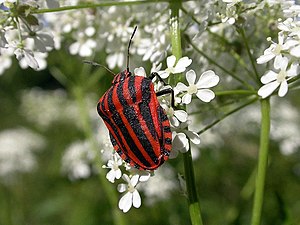Strip bug
| Strip bug | ||||||||||||
|---|---|---|---|---|---|---|---|---|---|---|---|---|

Strip bug ( Graphosoma italicum ) |
||||||||||||
| Systematics | ||||||||||||
|
||||||||||||
| Scientific name | ||||||||||||
| Graphosoma italicum | ||||||||||||
| ( OV Müller , 1766) |
The Streifenwanze ( Graphosoma italicum ) is a bug from the family of stink bugs (Pentatomidae). In German literature it was usually listed under the name Graphosoma lineatum . However, genetic investigations made it plausible that Graphosoma lineatum only occurs in Sicily and North Africa.
features
The animals reach a body length of 8 to 12 millimeters. They are unmistakable in Central Europe because of their striking, eponymous stripe pattern. On the top they have six black vertical stripes on a red or yellow-red background. The underside is red and has black spots. Atypical of stink bugs as a whole, but characteristic of the subfamily Podopinae, is the very large scutellum that covers the entire front wing ( hemielytra ). The antennae and legs are black. From Graphosoma lineatum in the narrower sense the color of the legs is the main difference. With Graphosoma italicum these are completely or mostly black, with Graphosoma lineatum red. There are no differences in genital traits in either males or females. In southern Europe there are other, similar species of the genus such as the spotty strip bug ( Graphosoma semipunctatum , formerly also in southern Central Europe).
In contrast to the adults with a conspicuous warning color , the larvae of the species are inconspicuously brown in color.
distribution and habitat
The species is widespread in the western Palearctic and occurs in the entire Mediterranean area and in bordering western Asia, east to Iran, with the northern limit of range fluctuating strongly. In recent decades, the northern border in Western and Central Europe has expanded significantly to the north, so that the species now occurs as far as the North and Baltic Seas ( Jutland and southern Sweden). In Germany, the species occurs everywhere with the exception of the northwest and is not rare in some areas. The strip bug is widespread in Austria, but only common locally. The animals colonize open to partially shaded areas in dry to more humid habitats. They can also be found in the higher elevations of the low mountain range.
Way of life
The strip bugs are found on umbellifers (Apiaceae), such as on parsnips ( Pastinaca ), strand of hair ( Peucedanum ), angelica ( Angelica ), carrots ( Daucus ), ground elder ( Aegopodium ) and man litter ( Eryngium ). In the higher elevations of the low mountain range it is found on bearwort ( Meum athamanticum ), in gardens also on cultivated plants such as dill ( Anethum graveolens ) or fennel ( Foeniculum vulgare ). Trees near the plants, on which the adults are more common in spring, seem to be beneficial for the population of the bedbugs.
Both the nymphs and the adult animals usually sit on their food plants and suckle the ripening seeds there. The adults overwinter in dry litter or in plant cushions. The pairing takes place from the end of May and especially in June; the females then lay their eggs over the period June / July. Adult animals of the new generation appear from the end of July or August, but nymphs can be observed until October. One generation is trained every year.
Stages of development
The following pictures show several development stages of the strip bug as a nymph.
Taxonomy
The species was first described by Otto Friedrich Müller , as Cimex italicus . Auguste Puton synonymized it with Graphosoma lineatum in 1881 , which was generally accepted until 2006. François Dusoulier and Roland Lupoli then viewed them again as valid species different from Graphosoma lineatum . However, this was initially not generally accepted, the species was viewed as a subspecies of Graphosoma lineatum or its existence was even completely rejected. Only after it could be substantiated by genetic data the fact that it is not just a color variety of the strip bug, the separation found further acceptance.
The genus Graphosoma comprises a total of ten species that are distributed in Palearctic Asia, the Mediterranean region and Europe. There are five species in southern Europe. Graphosoma italicum is the only Central European species.
supporting documents
Individual evidence
- ↑ a b Roland Lupoli (2017): Graphosoma lineatum (L., 1758) et G. italicum (OF Müller, 1766), deux espèces valides et distinctes, probablement issues de la transgression zancléenne méditerranéenne (Hemiptera Pentatomidae). L'Entomologiste 73 (1): 19-33. Full text at researchgate.net
- ^ Strip bug - Graphosoma lineatum (LINNAEUS, 1758). www.natur-in-nrw.de, accessed on November 18, 2013 .
- ^ A b c Ekkehard Wachmann , Albert Melber, Jürgen Deckert: Bugs. Volume 4: Pentatomomorpha II: Pentatomoidea: Cydnidae, Thyreocoridae, Plataspidae, Acanthosomatidae, Scutelleridae, Pentatomidae. (= The animal world of Germany and the adjacent parts of the sea according to their characteristics and their way of life . 81st part). Goecke & Evers, Keltern 2008, ISBN 978-3-937783-36-9 , pp. 185 ff .
- ↑ François Dusoulier and Roland Lupoli (2006): Synopsis of Pentatomoidea Leach, 1815 de France métropolitaine (Hemiptera: Heteroptera). Nouvelle Revue d'Entomologie (NS) 23 (1): 11-44.
- ↑ Jean Péricard: Hémiptères Pentatomoidea Euro-méditerranéens. Volume 3: Podopinae et Asopinae. Faune de France n ° 93. ISBN 978-2-903052-32-4
- ↑ Berend Aukema, Christian Rieger & Wolfgang Rabitsch: Catalog of the Heteroptera of the Palaearctic Region. Volume 6. Supplement. Published 2013 by The Netherlands Entomological Society, Amsterdam, The Netherlands. ISBN 978-90-71912-35-1 , on p. 472.
literature
- Ekkehard Wachmann , Albert Melber, Jürgen Deckert: Bugs. Volume 4: Pentatomomorpha II: Pentatomoidea: Cydnidae, Thyreocoridae, Plataspidae, Acanthosomatidae, Scutelleridae, Pentatomidae. (= The animal world of Germany and the adjacent parts of the sea according to their characteristics and their way of life . 81st part). Goecke & Evers, Keltern 2008, ISBN 978-3-937783-36-9 .







